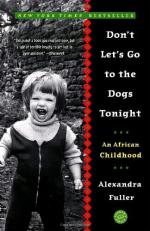
|
| Name: _________________________ | Period: ___________________ |
This test consists of 15 multiple choice questions and 5 short answer questions.
Multiple Choice Questions
1. What color hair is Vanessa described as having in the narrative?
(a) Brown.
(b) Black.
(c) Red.
(d) Blonde.
2. The holding areas for the prisoners at the police station are compared with what in Chapter 11: "War 1976"?
(a) Train cars.
(b) Sheds.
(c) Closets.
(d) Dog runs.
3. What kind of vehicle does the narrator describe having ridden on top of singing patriotic songs with her sister in Chapter 16: "Afterward"?
(a) A Bentley.
(b) A Jeep.
(c) A Porsche.
(d) A Land Rover.
4. What did Bobo and her sister discover on the farm in Chapter 18: "Chimurenga, 1979"?
(a) An ammunition cache.
(b) Abandoned rebel camps.
(c) A pile of bones.
(d) Two diamonds.
5. How many dogs accompanied the narrator, her mother, and her sister in traveling to Rhodesia in Chapter 7: "England 1969"?
(a) 3.
(b) 2.
(c) 5.
(d) 7.
6. What is the name of Alexandra Fuller’s mother?
(a) Olivia Fuller.
(b) Vanessa Fuller.
(c) Jayne Fuller.
(d) Nicola Fuller.
7. During Kenya’s war for independence, how many black Kenyans were killed, according to the narrator in Chapter 3: "Chimurenga I: Zambia, 1999"?
(a) 77,000.
(b) 49,000.
(c) 13,000.
(d) 25,000.
8. Which students attended the A schools?
(a) Mixed-race and Indian students.
(b) White students.
(c) American students.
(d) Black students.
9. What word from Chapter 2: "Getting There & Zambia 1987" means to designate a school, park, etc. for use by all races or groups?
(a) Propagate.
(b) Associate.
(c) Migrate.
(d) Integrate.
10. What did the narrator’s father allow the farm workers to do to the robbers in Chapter 19: "Violet"?
(a) Yell at them.
(b) Shoot them.
(c) Beat them.
(d) Drown them.
11. What did the narrator’s mother offer to the medics before they left in Chapter 19: "Violet"?
(a) Whiskey or a beer.
(b) Orange juice or coffee.
(c) Lemonade or milk.
(d) Tea or a cocktail.
12. According to the narrator in Chapter 6: "Coming-Back Babies,” in African tradition, an infant who dies must be buried among what?
(a) Flowers.
(b) Fruit.
(c) Diamonds.
(d) Tree roots.
13. How did Olivia Jane Fuller die?
(a) She was hit by a car.
(b) She contracted hepatitis.
(c) She drowned.
(d) She was in a plane crash.
14. What was everyone treated to at the sale barn in Chapter 20: "Selling”?
(a) A buffet breakfast.
(b) Cheese samples.
(c) Wine tastings.
(d) A six-course dinner.
15. In what year was Alexandra Fuller born?
(a) 1969.
(b) 1948.
(c) 1937.
(d) 1976.
Short Answer Questions
1. What phrase does the narrator use to describe her mother growing increasingly drunk in Chapter 2: "Getting There & Zambia 1987"?
2. On the trip taken by the Fullers in Chapter 17: "Vacation,” the narrator and her sister sang while their mother did what?
3. The narrator states in Chapter 10: "Chimunenga 1974" that the black Africans had been fighting a revolution against whites for how many years?
4. What did Bobo’s mother offer the border guard as a bribe in Chapter 2: "Getting There & Zambia 1987"?
5. What refers to the preserves in Rhodesia where the black Africans lived prior to the revolution, similar to Indian reservations in the U.S.?
|
This section contains 461 words (approx. 2 pages at 300 words per page) |

|




